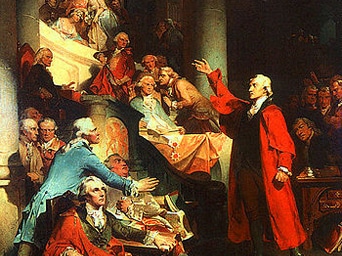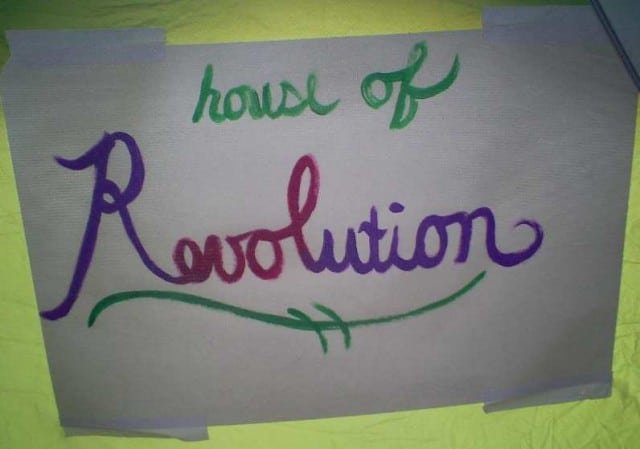
The agitators who are taking it to the streets would be the modern day Patriots.
Editors’ NOTE: Revolutions may be started or planted in a day or overnight… but it takes a while for them to grow, mature and bear fruit.
Usually an entire season.
How long is a “national development” season?
America is into its 200 somethingth year and, although seemingly well rooted, and even putting out tentacles or dendrons to the rest of the world like crab grass, it still does not seem to have matured, blossomed, or appear to be going to bear fruit. And it is in fact, beginning to show evidence of root rot…beginning to wither and dry up in the soil in which it was planted.
Perhaps the time is ripe to replant and start over again.
You can always count on Americans to do the right thing – after they’ve tried everything else. Winston Churchill
Edited. by: Debbie Menon
What is happening in the streets today is being hailed by some as the Second American Revolution, and it may very well be that our tree of liberty is beginning to bloom anew.
by LORI SPENCER
 Sign on a tent at the Oklahoma City Occupation (photo by Lori Spencer) by ThisCantBeHappening!
Sign on a tent at the Oklahoma City Occupation (photo by Lori Spencer) by ThisCantBeHappening!
“There are combustibles in every state which a spark might set fire to.”
— George Washington’s letter to General Henry Knox concerning the
Shay’s Rebellion, 1786
One month ago, a group of some 1000 demonstrators gathered in Manhattan’s Zuccotti Park to protest the pillaging of the nation’s economy by powerful corporations and international houses of high finance. While these young activists were entirely peaceful, they also made it clear that this would be no hippie-dippy flower-twirling love-in, sit-in, teach-in, or even a camp-in; this was an occupation. The demonstrators announced that they intended to Occupy Wall Street 24/7, staying until hell freezes over if need be.
The New York City police welcomed them warmly with pepper spray and more than a few violent smack-downs, even going so far as to arrest some 700 protesters on the Brooklyn Bridge who were lured into a position where they could be charged with blocking traffic.
After video of these outrages went viral on the Internet, a wave of righteous indignation swept the land. Hastily-formed Occupy groups proclaiming themselves in solidarity with the NYC protesters began to spring up in big cities and small towns across America. At first it was just a handful: 20-30 groups in the first week, growing to a few hundred in the second week, then rapidly mushrooming to today’s current total of 1,947 cities around the globe.
The most common critique leveled against the Occupy demonstrators is that they don’t seem to have a plan. “Disorganized,” “unfocused,” and “aimless” are buzzwords the movement’s detractors –both liberal and right-wing — like to toss around. Last week former President Bush’s key political adviser Karl Rove cynically opined in the Wall Street Journal that Democrats should distance themselves from the Occupy Wall Street movement to avoid alienating potential voters in 2012.
And it’s true that even those Americans who are in fact part of the 99% and generally support OWS’s principles are themselves unclear as to what the protesters ultimately want and how exactly they are going to accomplish it. What are their demands? How long are they going to keep this up? Have they proposed any concrete solutions? But that’s an awful lot of pressure to put upon a spontaneous social movement that is only little over a month old.
Certainly these are valid questions. In defense of the revolutionaries, though, remember that the last time we had a revolution in this country , it took 20 years to start it, eight years to fight it, and still another six years to fully secure and implement a new government.
If the Occupy movement is indeed the genesis of a Second American Revolution , we should not expect its progenitors to simply cough up a prefabricated quick fix. After all, if our elected representatives couldn’t seem to figure out how to correct the country’s multitude of problems over a few decades, is it reasonable to expect a loosely-organized band of citizen activists to offer the solutions within just a few months? We may be sowing the seeds of a revolution now, but let’s not forget that it usually takes many years to reap the harvest.
History shows that revolutions do not occur overnight. Reasonable humans always prefer to work out their differences through lawful avenues and communication whenever possible. It is only after many years of futile petitioning that the oppressed are left with no other choice but to revolt. Some 236 years ago, the American colonists signed a Declaration of Independence — prepared to back it up through force of arms if necessary — but that unforgiving line in the sand was only drawn after 22 years of peaceful attempts to negotiate with Britain had failed.
The seeds of the American Revolution were planted not in 1776, but in 1754 during the French and Indian War. Colonists became further disenchanted when taxes were levied upon them to pay the costs of that war. A number of other encroachments added fuel to the fire : restrictions on settlement of the West, increased duties on imported goods, the Stamp Act, the banning of colonial currency, outlawing town meetings, quartering British troops among the citizenry, and closing Boston Harbor, just to name a few. Discontent festered for nearly 20 years whilst the Loyalists and Patriots argued amongst themselves as to whether or not they dared to overthrow British rule.

When the first armed conflict of the Revolutionary War began on April 19, 1775, only one-third of colonists supported the cause. The Declaration of Independence was adopted by the Second Continental Congress on July 4, 1776, but it took another year for all the delegates to actually sign their John Hancocks, quite literally putting their lives on the line for what they believed in. Although the final battle was fought in 1782, the state of war did not formally end until the Treaties of Paris and Versailles were ratified in 1784. The U.S. Constitution was written in 1787 but was not ratified until 1789. This delay was the result of ongoing debate between Federalists and Anti-Federalists over just how much power the new national government should have. Debates were so heated in fact that they frequently turned into armed skirmishes, standoffs, and deadly showdowns with authorities. One resonant example was Shay’s Rebellion, a populist uprising of debt-ridden New England farmers who had served their country in the war, only to come home and have their lands foreclosed upon. (A scenario all too familiar for today’s veterans of the wars in Iraq and Afghanistan, as well as the returned veterans of practically every war in the 20th century.).
“You say you want a revolution…well, you know…we’d all love to see the plan.”
— The Beatles, “Revolution”
Revolutions are a process of trial and error, of discarding what doesn’t work and eventually figuring out what does. Of course you can always count on revolutionaries to make some massive screw-ups along the way (such as George Washington’s bright idea to exclude blacks from the Continental Army, thus driving more than 20,000 African Americans to pick up guns for the British and turn them against their countrymen, for example). In truth, the original 13 American colonies were rarely in agreement on anything . While everyone could agree that the country was out of joint, reaching consensus on what to do about it proved far more difficult.
Even when all 13 colonies finally signed on the dotted line in 1776, they still didn’t have a plan for a new system of government to replace the old. And while the Declaration may have been a poetic statement of collective principles and grievances, it offered nothing in terms of solutions.
The Continental Army was a ragtag, disorganized, unruly band of volunteers who seemingly didn’t stand a snowball’s chance against the crushing might of Britain’s superior forces. These men fought an eight-year war without so much as a blueprint for what the hell they were going to do with their hard-earned freedom should they emerge victorious. Once the war was won, it took another six years of bickering, compromise, and re-tooling the Constitution before we finally had a supreme law of the land. All the while, Congress ran the United States because there was no leader; the new nation didn’t elect its first president until 1789.
All in all, the process of the American Revolution comprised 35 years–a generation.
What is happening in the streets today is being hailed by some as the Second American Revolution, and it may very well be that our tree of liberty is beginning to bloom anew. By that historical comparison, the agitators who are taking it to the streets would be the modern day Patriots. The majority who tell them to just sit down, shut up, get a job, and stop whining already are the Loyalists. All of these empty arguments being made today against the Patriots as a bunch of naive, ungrateful, disorganized fools are nothing new under the sun . W e Americans have heard that old saw somewhere before. Washington, Adams, Jefferson and even Tom Paine didn’t have all the answers in the beginning, either.
Not until 1774 did the First Continental Congress convene to draft an official list of grievances, a statement of principles, and plans for organized resistance to England within the colonies. This bold first step towards independence had been 20 years in the making.
Today’s revolutionaries actually seem to be moving forward much, much faster. Already, an Occupy Wall Street working group is calling for the election of a National General Assembly to meet on July 4, 2012 in Philadelphia. According to the 99% Declaration, ” 870 Delegates shall set forth, consider and vote upon a PETITION OF GRIEVANCES to be submitted to all members of Congress, The Supreme Court and President and each of the political candidates running in the nationwide Congressional and Presidential election in November 2012.” Now that sounds like a plan!
It took many decades of unsustainable excess and deep-rooted corruption for America to reach this critical stage of mass unrest. So no one should expect us to get out of this mess tomorrow.
We’re done with trusting politicians to sort it out for us. We have finally come to the inevitable conclusion that if we want the job done right, we’ll have to do it ourselves. We The People will fix this, even if we don’t know quite how to do it just yet. We will win some, lose some, fall on our faces sometimes, and learn from our mistakes as our forefathers did. If it took them at least 35 years to come up with a system that worked. Instant gratification is not something we can expect this time around, either. Give it time. Better yet, roll up your sleeves and help if you want change to happen faster. Many hands make light work, and we’ve got a hell of a lot of work to do.
To borrow from President Kennedy, who outlined the New Frontier’s goals for the 1960s in his inaugural address and called his fellow Americans to action: “All this will not be finished in the first 100 days. Nor will it be finished in the first 1,000 days, nor in the life of this administration, nor even perhaps in our lifetime on this planet. But let us begin.”
Source: www.thiscantbehappening.net
LORI SPENCER is a veteran journalist and musician based in Austin, Texas. She spent 25 years in the trenches of radio and print newsrooms by day while playing her music by night. Most recently she became one of the 99% when the mega media corporation she worked for laid off more than 7,000 writers and editors, informing them via a cold and impersonal email that their services would no longer be needed. Now just another unemployed journalist, she’s hitting the road to document the occupation as it spreads across the American heartland. You may find her visiting your city soon. If you see Lori at a rally and would like to help fund her quest for reporting the truth, please toss some spare change in her guitar case. Lori wrote this piece for ThisCantBeHappening and will be continuing to report on the movement from the nation’s heartland.
Global Revolution Tribute – a video by Ken O’Keefe
“Whereever you oppress people…wherever you deny them their basic human rights… people will eventually rise up.” – Ken O’ Keefe

Debbie Menon is an independent writer based in Dubai. Her main focus are the US-Mid- East Conflicts. Her writing has been featured in many print and online publications.
Her writing reflects the incredible resilience, almost superhuman steadfastness of the occupied and oppressed Palestinians, who are now facing the prospect of a final round of ethnic cleansing. She is committed to exposing Israel’s Lobbies’ control of ‘U.S. Middle East Policy. Control’ which amounts to treason by the Zionist lobbies in America and its stooges in Congress, and that guarantees there can never be a peaceful resolution of the Israeli-Palestinian conflict, only catastrophe for all, in the region and the world.
Her mission is to inform and educate internet viewers seeking unfiltered information about real events on issues of the US/Middle East conflicts that are unreported, underreported, or distorted in the American media. PS: For those of her detractors that think she is being selective and even “one-sided,” tough, that is the point of her work, to present an alternative view and interpretation of the US-Israel-Middle East conflict, that has been completely ignored in mainstream discourse.
The purpose is to look at the current reality from a different and critical perspective, not to simply rehash the pro-US/Israel perspective, smoke and mirrors that has been allowed to utterly and completely dominate Mainstream discourse.
ATTENTION READERS
We See The World From All Sides and Want YOU To Be Fully InformedIn fact, intentional disinformation is a disgraceful scourge in media today. So to assuage any possible errant incorrect information posted herein, we strongly encourage you to seek corroboration from other non-VT sources before forming an educated opinion.
About VT - Policies & Disclosures - Comment Policy



